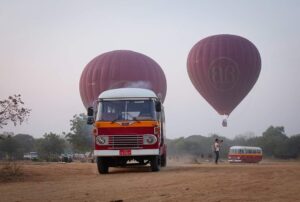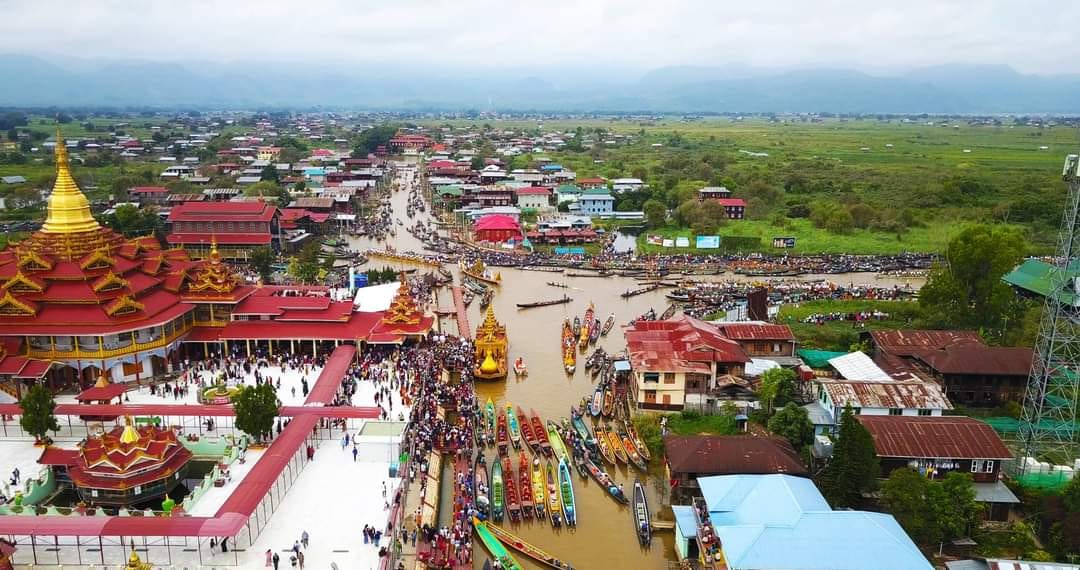Nestled in the heart of South east Asia, the question “where is Burma?” can be answered as follows: Burma, also known as Myanmar, is a land of unparalleled beauty and diversity. With its stunning landscapes, rich cultural heritage, and tumultuous history, this enigmatic nation offers a wealth of experiences for the curious traveler. Journey with us as we explore the fascinating world of Burma, from its magnificent temples and bustling cities to its serene beaches and vibrant ethnic communities.
Key Takeaways
- Burma is located in Southeast Asia and has diverse geography featuring mountains, plains, coastline along the Andaman Sea and the Bay of Bengal.
- Its cultural landscape is enriched by its regional neighbors with a variety of ethnic groups speaking different languages.
- Burma boasts vibrant landscapes hosting rich flora & fauna as well as historic sites & natural wonders that make it an ideal destination for travelers seeking unique experiences.
Location and Geography
Strategically positioned in Southeast Asia, Burma shares borders with:
- India
- China
- Laos
- Thailand
- Bangladesh
Burma’s history and diverse geography, which features stunning mountains, fertile plains, and an extensive coastline along the Andaman Sea and the Bay of Bengal, have been shaped by this unique location.
The geography of Burma includes:
- The highest point, Gamlang Razi, standing at 5,870 meters
- A mean elevation of 702 meters
- Breathtaking beaches
- Quaint fishing villages
- Access to significant shipping lanes along the extensive coastline.
Regional Neighbors
The nation’s ethnic makeup is remarkably diverse, influenced by the unique cultures and histories of the five countries that border Burma. The ethnic groups in Burma include:
- Chinese
- Laotian
- Thai
- Bangladeshi
- Indian
These diverse ethnicities create a vibrant tapestry of customs and traditions that enrich the country’s cultural landscape.
Coastal Features
Burma’s alluring coastline stretches along the Andaman Sea and the Bay of Bengal, characterized by:
- The Arakan Range
- narrow plains
- high ranges
- forests
- rocky ridges with deep channels
This picturesque setting, while being a haven for beach lovers and fishing enthusiasts, also plays a pivotal role in the nation’s economy by providing access to significant shipping lanes.
Climate and Terrain
Burma’s climate is majorly a tropical monsoon with hot, humid summers and mild winters. The terrain is varied with lush forests and fertile plains in the central lowlands and steep highlands, offering a variety of landscapes and ecosystems.
These varied environments house a wealth of natural beauty and provide unique habitats for the country’s exceptional flora and fauna.
Seasonal Changes
Burma experiences three main seasons: cool, hot, and rainy. The cool season extends from November to February, characterized by mild temperatures and low humidity.
In contrast, the hot season, running from March to May, brings high temperatures and humidity.
The rainy season, which lasts from June to October, is marked by heavy rains and high humidity, providing a welcome respite from the summer heat and supplying much-needed water for the agricultural sector.
Diverse Landscapes
From the lengthy coastline along the Andaman Sea and the Bay of Bengal to the central lowlands and rugged mountains, Burma’s diverse landscapes create a stunning backdrop for countless adventures. The country is home to a wealth of rare species, such as the Asian elephant, Bengal tiger, and Irrawaddy dolphin, as well as a myriad of bird species, including the critically endangered white-rumped vulture.
Ethnic Groups and Languages
Burma is home to a vibrant mix of ethnicities, with the majority being ethnic Burmans. The country recognizes 135 indigenous ethnic groups, the major national ethnic races, each with its own language and culture, making it one of the most diverse nations in Southeast Asia.
Minority Ethnic Groups
Besides the predominant Burmans, Burma is home to several minority ethnic groups including:
- Shan
- Karen
- Rakhine
- Rohingya
While these ethnic minority groups contribute to the country’s rich cultural tapestry, they have also faced persecution and challenges, particularly in regions affected by conflict and political instability, which often draws the attention of the United Nations.
Language Distribution
Although Burmese is the country’s official language, the linguistic diversity is enhanced by the many minority ethnic groups who speak their own languages. The nation’s major language families include:
- Sino-Tibetan
- Tai-Kadai
- Austroasiatic
- Indo-European
This reflects the rich tapestry of cultures that make up this fascinating land.
Economy and Natural Resources
Agriculture and natural resources, which are crucial for the country’s economic growth and development, form the base of Burma’s economy. The nation’s fertile plains support a thriving agricultural sector, while its abundant natural resources, such as timber, precious stones, natural gas, and hydropower, offer significant potential for further expansion.
Agriculture and Industry
The agricultural sector in Burma is largely focused on rice production, which accounts for approximately 43 percent of the total agricultural production value. Other crops cultivated include sugar cane, dry beans, and vegetables.
Industries like textiles, wood products, and construction materials, in addition to agriculture, contribute to the nation’s economic development.
Natural Resources
Burma is rich in natural resources, including:
- Petroleum
- Timber
- Precious stones
- Natural gas
- Coal
- Hydropower
These resources contribute to the country’s economic growth while also providing opportunities for sustainable development and attracting foreign investment.
As Burma continues to liberalize its economy and pursue political and economic reforms, its abundant natural resources will play a crucial role in shaping the nation’s future prosperity, moving away from its past as a socialist republic.
Culture and Religion
Buddhism plays a central role in Burma’s culture, with a majority of the population practicing the religion. The country’s diverse ethnic groups also contribute to its rich cultural heritage, adding a colorful tapestry of customs, traditions, and artistic expression that reflects the nation’s multi-faceted identity. In central Myanmar, this cultural diversity is particularly evident, showcasing the unique blend of influences from various ethnic communities.
Religious Practices
Although Buddhism is the main religion in Burma, the country also hosts smaller populations of:
- Christians
- Muslims
- Animists
- Hindus
These varied religious practices contribute to the nation’s cultural richness and provide a unique insight into the beliefs and values that shape Burma’s diverse communities.
Cultural Traditions
The diverse ethnic groups of Burma each have their own unique cultural traditions, including:
- Festivals
- Music
- Dance
- Cuisine
These vibrant expressions of culture not only provide a window into the country’s rich heritage but also serve as a testament to the resilience and creativity of its people, who have navigated a complex history of British colonial rule, military domination, and political upheaval.
Travel and Tourism

From bustling cities and ancient temples to pristine beaches and stunning natural landscapes, Burma offers a wealth of travel experiences for the adventurous explorer. With its diverse cultural heritage and breathtaking scenery, this enigmatic nation is a hidden gem in Southeast Asia that promises to captivate the hearts and minds of those who venture within its borders.
Must-Visit Cities
Key cities to visit in Burma include:
- Yangon – home to the magnificent Shwedagon Pagoda and the National Museum
- Mandalay – boasting the Mahamuni Pagoda, Mandalay Palace, and Kuthodaw Pagoda
- Nay Pyi Taw – the country’s capital, offering attractions such as the Uppatasanti Pagoda, the National Museum, and the Nay Pyi Taw Zoo.
Historic Sites and Natural Wonders
Burma hosts numerous historic sites and natural wonders, including:
- The ancient city of Bagan with its awe-inspiring temples and pagodas
- Inle Lake known for its unique floating villages and gardens
- The significant Irrawaddy River, which has played a critical role in the nation’s history and economy.
These remarkable destinations provide a glimpse into the country’s rich past and showcase the extraordinary beauty of its natural environment.
In conclusion, Burma is a land of contrasts, where ancient traditions coexist with modern aspirations, and diverse cultures converge to create a vibrant tapestry of life. From its stunning landscapes and historic sites to its rich cultural heritage and resilient spirit, this enigmatic nation offers a wealth of experiences for the intrepid traveler. As Burma continues to evolve and embrace the future, there has never been a better time to explore the wonders of this fascinating country and discover the stories that lie waiting to be told.
Frequently Asked Questions
What country does Burma belong to?
Myanmar, formerly known as Burma, is a country located in Southeast Asia. In 1989, the ruling military government changed its name from Burma to Myanmar, although the United States and the United Kingdom continue to recognize it by its old name.
What is Burma famous for?
Myanmar, previously known as Burma, is famous for its Buddhism, Nobel Peace Prize laureate Aung San Suu Kyi, and a blend of British colonial architecture and gilded pagodas.
What are some must-visit cities in Burma?
Yangon, Mandalay and Nay Pyi Taw are must-visit cities in Burma.

